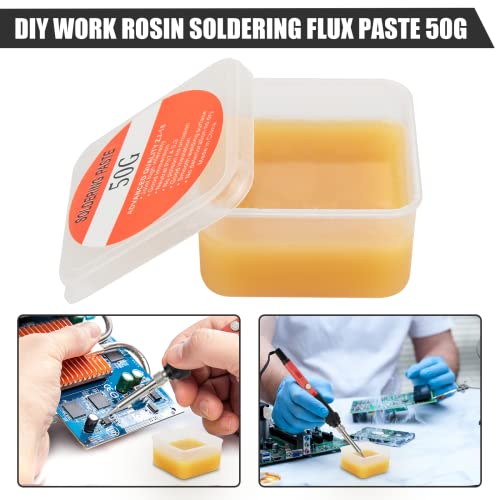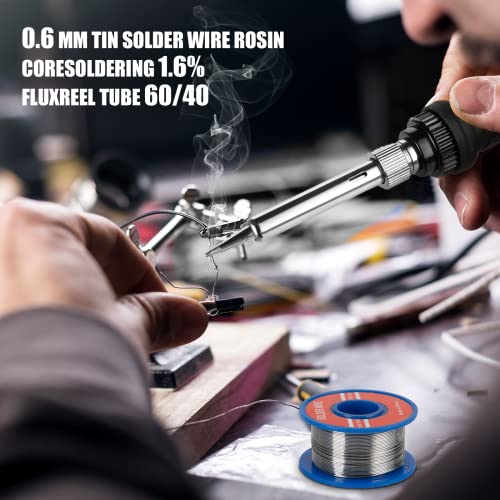
In comparing the ‘Brand 60W Iron’ and the ‘LCD Soldering Iron Kit,’ it is important to understand the unique features and functionalities of each device. By examining factors such as heating capacity, user interface, and overall performance, you can make an informed decision on which tool best suits your soldering needs. Let’s delve deeper into these aspects to help you determine which iron is the better choice for your projects.
Hobby Enthusiasts
The 60W Soldering Iron Kit is a versatile tool perfect for any hobby enthusiast. With adjustable temperature settings, quick heating, and a variety of interchangeable tips included, it’s an essential kit for circuit board welding, appliance repair, and DIY projects. Plus, it’s portable, user-friendly, and backed by a 2-year warranty and lifetime customer support.
Precision Crafting
Upgrade to a high-power 80W soldering iron that heats up in just 20 seconds, with precise temperature control from 180℃ to 480℃. Effortlessly tackle various projects with clear LCD display, efficient heat dissipation, anti-scalding handle, and versatile applications. The kit includes all essentials for beginners and enthusiasts alike, perfect for DIY projects, repairs, and more.
Brand 60W Iron
Power Source
ac
Wattage
60 watts
Temperature Range
200-450 Degrees Celsius
Handle Material
Ceramic
Upper Temperature Rating
450 Degrees Celsius
LCD Soldering Iron Kit
Power Source
ac
Wattage
80 watts
Temperature Range
180℃-480℃/ 356°F-896°F
Handle Material
Ceramic,Metal
Upper Temperature Rating
896 Degrees Fahrenheit
Brand 60W Iron
LCD Soldering Iron Kit
Brand 60W Iron
LCD Soldering Iron Kit
Affiliate links / Image courtesy of Amazon. As an Amazon Associate I earn from qualifying purchases.
Comparison chart


Affiliate links / Image courtesy of Amazon. As an Amazon Associate I earn from qualifying purchases.
Unique Selling Points (USPs):
- 60W Soldering Iron Kit:
- Adjustable temperature for precise control.
- Versatile 10-in-1 iron tips suitable for various soldering tasks.
- Ideal for hobbyists and general home projects.
- 80W LCD Digital Soldering Iron Kit:
- LCD display for accurate temperature monitoring.
- Faster heating and sustained performance.
- Suitable for metalwork, electronics, and intricate DIY projects.
Similarities:
- Both kits include multiple iron tips.
- Operate on 110V US plug.
- Great for soldering and welding applications.
Pros:
- Good value for money.
- Easy to use for beginners.
- High-quality construction for durability.
Cons:
- Limited temperature range in the 60W kit.
- Complex features may overwhelm beginners with the 80W kit.
- Basic accessories in the 60W kit may require additional purchases.
Use-Cases:
- 60W Kit: Ideal for casual hobbyists and minor repair work.
- 80W Kit: Recommended for advanced DIYers, professionals, and intricate projects.
Conclusive Assessment:
Affiliate links / Image courtesy of Amazon. As an Amazon Associate I earn from qualifying purchases.
Based on the comparison, the 80W LCD Digital Soldering Iron Kit emerges as the clear winner for users looking for precision, versatility, and advanced features. However, for hobbyists seeking affordability and simplicity, the 60W Soldering Iron Kit remains a solid choice.
Final Summary:
In conclusion, if you are a hobbyist looking for a reliable and straightforward soldering kit, the 60W option is a great fit. For users needing advanced capabilities and precise control, the 80W LCD Digital Iron Kit stands out as the optimal choice. Consider your skill level and project requirements to determine which kit best suits your needs.
Affiliate links / Image courtesy of Amazon. As an Amazon Associate I earn from qualifying purchases.
Comparing Soldering Iron Products
When looking at different soldering iron options, it’s important to consider various factors to make an informed decision. Here are some general guidelines and key factors to keep in mind:
Price
- Compare the prices of the soldering irons you are considering.
- Ensure you are getting good value for your money.
Heating Power
- Check the wattage of the soldering irons.
- Higher wattage typically means faster heating and better performance.
Temperature Control
- Look for soldering irons with adjustable temperature control.
- Temperature precision is crucial for different types of soldering projects.
Durability
- Assess the build quality and materials used.
- A durable soldering iron will last longer and provide more consistent results.
Accessories
- Consider which accessories come with each soldering iron.
- Kits that include additional tips, stands, or cleaners can offer more versatility.
Brand Reputation
- Research the reputation of the brands offering the soldering irons.
- Established brands may prioritize quality and customer support.
By evaluating these key factors, you can determine which soldering iron best fits your needs and budget. Happy soldering!
Soldering Iron FAQs
The price of the 60W soldering kit is generally lower compared to the LCD model. The 60W soldering kit is a more basic model with adjustable temperature settings and interchangeable iron tips, making it suitable for hobby enthusiasts. On the other hand, the LCD model is more advanced with a digital display, higher wattage, and additional accessories, which may result in a higher price point.
The key differences between a 60W and LCD soldering kit are:
- Power Output: The 60W soldering iron has a power output of 60 watts, while the LCD soldering kit is 80W, providing more power for soldering tasks.
- Display: The LCD soldering kit features an LCD display for precise temperature control, allowing you to monitor and adjust the temperature more accurately.
- Additional Accessories: The LCD soldering kit usually comes with more accessories like different tips, solder tube, sponge, solder paste, etc., offering a more comprehensive soldering experience.
- Heating Element: The 60W soldering iron typically comes with a standard heating element, while the LCD soldering kit may have a ceramic heater for efficient and consistent heat distribution.
For beginners, the 60W soldering kit is recommended over the LCD 80W kit. A 60W soldering iron is more suitable for beginners as it provides a good balance of power without being too hot or difficult to control. The adjustable temperature feature and interchangeable iron tips in the 60W kit make it versatile and user-friendly for hobbyists just starting out with soldering projects. The LCD 80W kit with digital features such as temperature control might be more advanced for beginners and could potentially be overwhelming until you gain more experience with soldering.
To choose the right soldering iron for electronics, you should consider a few key factors:
- Power/Wattage: For most electronics work, a soldering iron in the range of 25-75 watts should suffice. The 60W soldering iron in the first kit and the 80W soldering iron in the second kit fall within this range, making them suitable for electronics soldering.
- Temperature Control: Look for a soldering iron with adjustable temperature settings. Maintaining the correct soldering temperature is crucial for electronic components’ safety. The 10-in-1 adjustable temperature soldering iron in the first kit and the LCD digital soldering iron with ceramic heater in the second kit offer this feature.
- Compatibility and Accessories: Ensure that the soldering iron you choose comes with interchangeable iron tips suitable for different soldering tasks. Both kits mentioned come with multiple tips, stands, solder tubes, sponges, and other accessories essential for various soldering applications.
- Quality and Durability: Consider the build quality and durability of the soldering iron. A reliable ceramic heater, as in the second kit, can provide stable heating for precise soldering.
By assessing these factors, you can select a soldering iron that meets your electronic soldering needs effectively and efficiently.
Both soldering kits mentioned can handle a variety of soldering projects due to their adjustable temperature features, interchangeable tips, and additional accessories like stands, solder tubes, and sponges. The 60W soldering iron is suitable for hobbyists and offers versatility, while the 80W soldering iron with LCD digital display provides more power for metal or electric projects. With the right tools and accessories, both kits are capable of meeting the needs of various soldering tasks.












Thank you for sharing your favorite! The LCD Soldering Iron Kit indeed offers great convenience with its digital display.
It would be interesting to see a comparison with a portable soldering iron model included, like the XYZ Portable Soldering Iron, to cover different user needs.
That’s a great suggestion! I’ll consider including a portable soldering iron model in the next comparison post to provide a broader perspective. Thanks for your input!
Could you elaborate more on the wattage differences between the Brand 60W Iron and the LCD Soldering Iron Kit? How does it impact performance?
I personally prefer the LCD Soldering Iron Kit due to its digital display and temperature control feature.